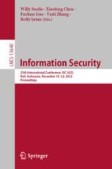Search
Search Results
-
XPORAM: A Practical Multi-client ORAM Against Malicious Adversaries
Oblivious RAM (ORAM) was proposed to solve the problem of memory disclosure, preventing the system from reverse engineering attacks. Naturally,...
-

-

-

-
Fast ORAM with Server-Aided Preprocessing and Pragmatic Privacy-Efficiency Trade-Off
Data-dependent accesses to memory are necessary for many real-world applications, but their cost remains prohibitive in secure computation. Prior...
-
3-Party Distributed ORAM from Oblivious Set Membership
Distributed Oblivious RAM (DORAM) protocols allow a group of participants to obliviously access a secret-shared array at a secret-shared index, and...
-
Alibi: A Flaw in Cuckoo-Hashing Based Hierarchical ORAM Schemes and a Solution
There once was a table of hashes That held extra items in stashes It all seemed like bliss But things went amiss When the stashes were stored in the...
-
Two-Server Distributed ORAM with Sublinear Computation and Constant Rounds
Distributed ORAM (DORAM) is a multi-server variant of Oblivious RAM. Originally proposed to lower bandwidth, DORAM has recently been of great...
-
Weighted Oblivious RAM, with Applications to Searchable Symmetric Encryption
Existing Oblivious RAM protocols do not support the storage of data items of variable size in a non-trivial way. While the study of ORAM for items of...
-

-
Locality-Preserving Oblivious RAM
Oblivious RAMs, introduced by Goldreich and Ostrovsky [JACM’96], compile any RAM program into one that is “memory oblivious,” i.e., the access...

-
Privacy Preserving Computation in Cloud Using Reusable Garbled Oblivious RAMs
When users store encrypted data in a cloud environment, it is important for users to ask cloud to carry out some computation on the remote data...
-
MacORAMa: Optimal Oblivious RAM with Integrity
Oblivious RAM (ORAM), introduced by Goldreich and Ostrovsky (J. ACM ‘96), is a primitive that allows a client to perform RAM computations on an...
-
TimeClave: Oblivious In-Enclave Time Series Processing System
Cloud platforms are widely adopted by many systems, such as time series processing systems, to store and process massive amounts of sensitive time...
-
Random-Index Oblivious RAM
We study the notion of Random-index ORAM (RORAM), which is a weak form of ORAM where the Client is limited to asking for (and possibly modifying)...
-
Snapshot-Oblivious RAMs: Sub-logarithmic Efficiency for Short Transcripts
Oblivious RAM (ORAM) is a powerful technique to prevent harmful data breaches. Despite tremendous progress in improving the concrete performance of...
-
Is There an Oblivious RAM Lower Bound for Online Reads?
Oblivious RAM (ORAM), introduced by Goldreich (STOC 1987) and Ostrovsky (STOC 1990), can be used to read and write to memory in a way that hides...

-
Obric: Oblivious Keyword Search in Hyperledger Fabric Platform
Access pattern disclosure can reveal sensitive information related to search queries, posing a threat to user privacy. Malicious attackers may infer...
-
Limits of Breach-Resistant and Snapshot-Oblivious RAMs
Oblivious RAMs (ORAMs) are an important cryptographic primitive that enable outsourcing data to a potentially untrusted server while hiding patterns...
-
Efficient 3-Party Distributed ORAM
Distributed Oblivious RAM (DORAM) protocols—in which parties obliviously access a shared location in a shared array—are a fundamental component of...
